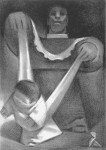
Although born in Paris, France, artist Jean Charlot (1898-1979) was most intrigued by his Mexican heritage, which he conveyed in his paintings. Exposed to pre-Hispanic native culture since the age of two through his mother, Charlot would eventually live and work in Mexico where he began his impact in the local art community through archeological sketches and, later, became a large contributor in the Mexican Mural movement. His artwork consisted of monumental murals, lithographs, and book illustrations. In addition, throughout his life, Charlot taught at numerous colleges, universities, and art centers until his death in 1979.
One of his favorite themes concerned the family, the home, and the everyday lives of “everyday” people. His art captured scenes of events that were both ordinary and significant often focusing on women’s work such as in Women with Basket in Buff, (1968) The Little Seamstress (1974). Charlot created images that depicted simple life events, such that all people could relate to and find pride in, even the working class. His emphasis on the simplistic, universal human lifestyle made him known as the “Champion of the Everyday.”[i]
Every family can relate to the experience of a child’s first steps, rich or poor. In 1946, Charlot created the black and white lithograph called, First Steps. The artwork depicts a mother holding up her child with a blanket as it takes his or her first steps. In Mexico, this particular blanket is known as a rebozo, a cloth used by women to support the child as it takes its first steps.[ii] A child’s first steps represent an important act towards more independence. But while Charlot’s child takes its first steps, the mother looms large in the background, giving her child more freedom. In addition to this, the mother is also large, with bold features revealing her motherly strength.
In relations to other works by Charlot around this time, First Steps seems to be a part of an ongoing series of prints describing the relationship between mother and child.[iii] This particular print is a newer version of Charlot’s First Steps (1939). But Charlot’s lithograph, Station XIII: The Descent from the Cross (1934), perhaps makes a more interesting comparison. In this print, Charlot depicts Christ being lowered from the cross with a cloth, in a similar, cradling fashion. In First Steps, one can recognize that the “first steps of childhood foreshadow the descent from the Cross,”[iv] revealing another of Charlot’s favorite themes, religion. The sacrifice that Jesus made on the cross for the people He loved can be paralleled to the love of people within a domestic relationship. Charlot was perhaps implying that just as Jesus sacrificed himself to help the world, a mother would make a sacrifice for the safety of her own child; a heroic trait in a domestic environment.
The simplicity of the work, with minimal detail and a black and white color scheme, adds more emphasis on the message behind the piece. It allows the viewer to take the focus off of the artwork itself and instead think about the intended theme, the domestic relationship between a mother and child. The piece represents a child’s desire to be independent and a mother helping them to do so whilst still being able to nourish and support them.
CA
[i] “Jean Charlot.” Isaac Art Center. Hawaii Preparatory Academy, n.d. Web. 12 Apr 2011. <http://isaacsartcenter.hpa.edu/taxonomy/term/19?page=1>.
[ii] Jean Charlot: A Retrospective. Honolulu, HI: The University of Hawai’i Art Gallery, 1990. 82. Print.
[iii] Morse, Peter. Jean Charlot’s prints: a catalogue raisonné. Honolulu, HI: University Press of Hawaii, 1976. Print.
[iv] Jean Charlot: A Retrospective. Honolulu, HI: The University of Hawai’i Art Gallery, 1990. 81. Print.